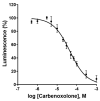A Cellular Assay for the Identification and Characterization of Connexin Gap Junction Modulators
- PMID: 33572565
- PMCID: PMC7866863
- DOI: 10.3390/ijms22031417
A Cellular Assay for the Identification and Characterization of Connexin Gap Junction Modulators
Abstract
Connexin gap junctions (Cx GJs) enable the passage of small molecules and ions between cells and are therefore important for cell-to-cell communication. Their dysfunction is associated with diseases, and small molecules acting as modulators of GJs may therefore be useful as therapeutic drugs. To identify GJ modulators, suitable assays are needed that allow compound screening. In the present study, we established a novel assay utilizing HeLa cells recombinantly expressing Cx43. Donor cells additionally expressing the Gs protein-coupled adenosine A2A receptor, and biosensor cells expressing a cAMP-sensitive GloSensor luciferase were established. Adenosine A2A receptor activation in the donor cells using a selective agonist results in intracellular cAMP production. The negatively charged cAMP migrates via the Cx43 gap junctions to the biosensor cells and can there be measured by the cAMP-dependent luminescence signal. Cx43 GJ modulators can be expected to impact the transfer of cAMP from the donor to the biosensor cells, since cAMP transit is only possible via GJs. The new assay was validated by testing the standard GJ inhibitor carbenoxolon, which showed a concentration-dependent inhibition of the signal and an IC50 value that was consistent with previously reported values. The assay was demonstrated to be suitable for high-throughput screening.
Keywords: GloSensor luciferase; HeLa cells; compound library; connexin-43; gap junctions; screening.
Conflict of interest statement
The authors declare no conflict of interest.
Figures









Similar articles
-
Gap junctional communication promotes apoptosis in a connexin-type-dependent manner.Cell Death Dis. 2013 Apr 11;4(4):e584. doi: 10.1038/cddis.2013.105. Cell Death Dis. 2013. PMID: 23579271 Free PMC article.
-
A Cell-Based High-Throughput Assay for Gap Junction Communication Suitable for Assessing Connexin 43-Ezrin Interaction Disruptors Using IncuCyte ZOOM.SLAS Discov. 2017 Jan;22(1):77-85. doi: 10.1177/1087057116669120. Epub 2016 Sep 26. SLAS Discov. 2017. PMID: 27628689
-
High-Content Screening Identifies New Inhibitors of Connexin 43 Gap Junctions.Assay Drug Dev Technol. 2019 Jul;17(5):240-248. doi: 10.1089/adt.2019.927. Assay Drug Dev Technol. 2019. PMID: 31314551
-
Connexin 43 (Cx43) in cancer: Implications for therapeutic approaches via gap junctions.Cancer Lett. 2019 Feb 1;442:439-444. doi: 10.1016/j.canlet.2018.10.043. Epub 2018 Nov 22. Cancer Lett. 2019. PMID: 30472182 Review.
-
Astrocytic Connexin43 Channels as Candidate Targets in Epilepsy Treatment.Biomolecules. 2020 Nov 20;10(11):1578. doi: 10.3390/biom10111578. Biomolecules. 2020. PMID: 33233647 Free PMC article. Review.
Cited by
-
Glial connexins in glaucoma.Front Neurosci. 2025 Apr 9;19:1560344. doi: 10.3389/fnins.2025.1560344. eCollection 2025. Front Neurosci. 2025. PMID: 40270762 Free PMC article. Review.
-
An Ultrasensitive Genetically Encoded Voltage Indicator Uncovers the Electrical Activity of Non-Excitable Cells.Adv Sci (Weinh). 2024 May;11(20):e2307938. doi: 10.1002/advs.202307938. Epub 2024 Mar 25. Adv Sci (Weinh). 2024. PMID: 38526185 Free PMC article.
-
From the Matrix to the Nucleus and Back: Mechanobiology in the Light of Health, Pathologies, and Regeneration of Oral Periodontal Tissues.Biomolecules. 2021 May 31;11(6):824. doi: 10.3390/biom11060824. Biomolecules. 2021. PMID: 34073044 Free PMC article. Review.
-
Applicability of Scrape Loading-Dye Transfer Assay for Non-Genotoxic Carcinogen Testing.Int J Mol Sci. 2021 Aug 20;22(16):8977. doi: 10.3390/ijms22168977. Int J Mol Sci. 2021. PMID: 34445682 Free PMC article. Review.
References
Publication types
MeSH terms
Substances
LinkOut - more resources
Full Text Sources
Other Literature Sources
Miscellaneous

